|
|
|
|
Francesco Schettino, the Master of the ship, had, we are told, at the request of the ship owners, decided before departing Civitavecchia on the way to Savona of a sail-past of Giglio Island with a safety margin of 0.5 nautical miles (about 1 km) from the coast or the 10-meter safety contour. The sail-past represented a
minor deviation from the standard course from
Civitavecchia to Savona, in well-known waters, as
several quite similar sail-pasts had previously
been carried out in these waters. To do so you should evidently
set course for the Giglio island at once at
departure and pass the island on the port side at 1
km distance ... without turning ... but NO!
The ship went straight for
Savona at departure and only later, during
the leg between the two Italian ports, some
officers on the bridge, turned the ship port
straight towards the Giglio island
for Schettino to carry out a sharp
starboard turn at the last moment to impress
the passengers & Co. Of course no passengers
aboard were told about this strange show
According to the voyage plan established by the 2nd Officer and approved by Schettino before departure at Civittavecchio (sic) the vessel arrives with heading 278° and, between 21.38 and 21.42 hrs in complete darkness about >1 600 m from the south end of Isola del Giglio, the course is changed to 334° - you make a turn of 56° to starboard - and the vessel then passes the Isola del Giglio at a safe distance of about >800 m between 21.44 and 21.48 hrs. The passengers could enjoy the view of the island during four minutes ... if they saw it. It was pitch dark outside! No announcement of a sail-by was done! It sounds easy doesn't it? And looks very, very strange. According Wikipedia something completely different happened: ... Schettino stated that, before approaching the island, he turned off the alarm system for the ship's computer navigation system. "I was navigating by sight, because I knew those seabeds well. I had done the move three, four times." He told investigators that he saw waves breaking on the reef and turned abruptly, swinging the side of the hull into the reef. "I have to take responsibility for the fact that I made a judgment error." "This time I ordered the turn too late." The captain initially stated that the ship was about 300 metres (330 yd) from the shore (about the length of the vessel) and hit an uncharted rock. However, the ship's first officer, Ciro Ambrosio, told investigators that Schettino had left his reading glasses in his cabin and repeatedly asked Ambrosio to check the radar for him. Evidently the above is a typical Wikipedia falsification of what happened. According VDR data (see below) something completely different happened - the simple turn remains incomprehensible. M/S Costa Concordia had excellent maneuvrability particulars and could turn 90° starboard in less than 90 seconds without heeling too much (stabilizers were fitted), while advancing <700 meters. So as long as you start your turn a mile (1 852 m) ahead of the coast, you will pass parallell to the coast at >1 100 m distance as planned. It had apparently been done before (August 2011) at night and looked like this! But no turn then! Just a parallell passing! However, if you start the turn a little late, you will end up much closer to the shore (and underwater rocks) of the island! So what really happened 13
January 2012? Why didn't the ship sail straight
for the Giglio island at departure to pass
safely without turning, which had been done
before? Why these turns first port towards and then
starboard along the island during the leg to
Giglio? We do not know! It is very simple to find out
what really happened during the six minutes prior
the 21.45 hrs contact as the
Voyage
and Voice Data
Recorders,
VDR, records (i) Speed log - Speed
through water or speed over ground before and after
the contact, capsize and final
sinking, (ii) Gyro compass - Heading before
and after the contact, (iii) Radar
- it gives ship's position at any time and
before and after the contact, capsize
and final sinking and, (iv) Rudder -
Position, order and feedback response,
Voices/Orders given, etc. Some data have been made
available (see left) but without a clock. Ship
turns starboard during five minutes and contacts a
hidden rock! We have been told that vessel
turned too late ... and in the wrong direction.
Watch/listen to this
made public October 2012. Already at 21.39.32 hrs
Schettino orders 300 starboard, which is not
too late but as planned! Watertight doors #12 and
#13 are open ... at sea ... which is illegal! At
21.43.38 hrs the ship is still heading up on
land ... and nobody seems to note it! Watertight
doors #7, #12 and #13 are open! 80 seconds before the
contact occurs at 21.45.15 hrs and probably
600/700 meters away from any Isola del Scole rocks
Schettino orders "350 starboard! Otherwise we go
on the rocks". Note rocks -
plural! It seems Schettino can
sea the island and rocks himself and orders three,
five, zero not threehundredfity ... that the
Indonesian helmsman does not understand. If they
had turned starboard one minute earlier, there
would have been no contact. According the final Italian accident investigation report at www.safety4sea.com/images/media/pdf/Costa_Concordia_-_Full_Investigation_Report.pdf (copy/paste the link) issued May 2013, we are told following happened apparently based on voice recordings: "At 21.34.36 hrs the Master comes on the bridge and orders the helmsman to move the rudder in manual mode. … How this is established from a voice recording is unclear. Did Schettino say Ciao? And where on the rather big bridge does Schettino position himself? Forward at the centreline? Or in a sofa at the back? Schettino says it was the 2O that gave the order, while he was talking on the phone. At 21.39.14 hrs, with a 290° heading, the Master takes the command of the watch. According to the plan the starboard turn shall start at once now! But how can you know the heading from a voice recording? They had thus already turned 12° a little earlier. Schettino has another opinion what happened. He took command much later, when he suddenly observed some white foam ahead of the ship, and realized that they were heading straight for the shore. He then immediately took the command and started a last moment evasive manoeuvre by ordering steering directions to the helmsman and the bridge team. But officially - five minutes 37 seconds before 'contact' at 21.45. 07 hrs the following happens: At 21.39.30 hrs with speed 3.15 (15.3?) Master orders the helmsman to go for 300°*, and at 21.40.00 hrs orders to increase to 16 knots and then to pull "gently" to 310°*. Till this point the ship is still on the course as planned (sic) and the radar displays a VRM at 0.5 miles. The bow heads towards "Punta Capo Marino" and the ship proceeds, at a distance of 1.35 miles (2 500 meters) and a speed of 15.4 knots. … The planned course/route was a 2 minutes starboard change of heading from 278° to 334° at 21.38-21.42 hrs! If Schettino had at 21.39.30 hrs ordered the helmsman to put the rudder 10° starboard and go for 334°, the turn would have been done as planned in two minutes. So what was the rate of turning °/minute? We are not told! Instead - very strange: At 21.40.48 the Master orders, in English, ".. 325* .." the helmsman answers, to confirm the order ".. 315* ..", the First Deck Officer intervenes to correct the interpretation of the helmsman but pronounces ".. 335* .." then the Master reiterates its order ".. 325* .." and then the Helmsman confirms ".. 325* ..". Funny conversation. Schettino orders in English (in spite of working language being Italian) a starboard turn (to 325°*) but the helmsman answers 315* and may have turned to port. Maybe here the ship got on the wrong heading? * We do not know if the order is three zero zero, three ten, three tventy five or three two five or three hundred, three hundred ten, etc, and what the helmsman actually says ... and what rudder action is taken ... or whether the helmsman is sober and in shape to work. We do not know, if and when the helmsman actually turned the rudder, and how much - 1°, 5°, 10°, 20° or hard 35°! The conversation does not tell at all how the ship turned ... if at all. And we do not know the actual trajectory of the ship or if the steering gear worked. It is not clear, if Schettino /helmsman had ever trained this exercise - change heading close to shore at 15.3 knots speed or anything similar before or ever. So 4 minutes before 'contact' occurs the heading should be 325° and it seems the ship was 2 500 meters away from shore a little earlier on the port side. The courses are not the ones on the voyage plan - a simple turn from 278° to 334°. We do not know why they didn't follow the agreed plan and we do not know what actually happened according to the Voyage and Voice Data Recorder. Because: The ship is at about 0.5 miles (900 m) far from the coast. Suddenly ship was very close, 900 m, to shore but the heading is only ~315° and turning north, so maybe everything will still be OK? The data show that VDR when the VRM circle "touches" the shore is going to be deactivated. Is the VDR deactivated, when the VRM circle "touches' something? Very strange! The VDR should record all data all the time! At 21.42.07 hrs is ordered 330° and the helmsman answered correctly. This is three minutes before contact and you should thus easily turn starboard away from shore at the port side. But did the ship turn starboard? We do not know. And nobody seems to care. At 21.42.40 hrs Master sends the 2nd Officer on the left (i.e. port) wing, the speed is about 16 knots. Why does Schettino send the 2/O on the left wing two and a half minutes before contact? What shall the 2/O do on the port bridge wing? To see if the ship turned? It is complete darkness outside. We do not know. Isn't it better to watch the radars? You have at least two radars! At 21.43.08 hrs is ordered 335°. It is of course interesting to know what is ordered, but what was the actual headings/courses at the various times? We do not know. Why isn't the complete trajectory established, with the various positions/times/speeds/course indicated when orders were given? At 21.43.33 hrs is ordered 340°. 90 seconds before contact occurs, the heading should be >335° and you should pass parallell with the shore on the port side. But what was the heading or course? We don't know! The official report gets stranger and stranger. At 21.43.44 hrs the speed is 15.9, the Master orders, always in English, ".. 350* ..", the helmsman does not confirm properly (it repeats 340*) and the order is confirmed again, specifying the side "starboard" and warning that otherwise would end up on the rocks (taken from video recordings (sic) of the VDR to 21 43 46 the bow is oriented to 327°). Hm, wasn't the VDR deactivated (sic) at 21.42.00 hrs? And what is a video recording of a VDR? Regardless, if the course was really 327° two minutes prior contact, you would evidently pass the island at the port side at safe distance. But again there are misunderstandings and maybe the incident really occurred here: The turn (sic) is still in progress when the ship is at 21.44.05 hrs in position 42°21'05 "N 010° 6'E, with the bow in the direction of "Le Scole " at 0.3 miles (550 meters) and a speed of 16 knots. Why is the ship in this strange position? Is the ship still heading up on land? Has no starboard turn taken place? How did it end up there? And normally speed is reduced when your turn. The turning radius is such that the ship is located 0.5 miles (900 meters) SW of the planned (sic) route so much closer to the coast than planned (sic). So the ship is suddenly 900 m off course and closer to land than planned, after having turned away from land during >2 minutes. How is this possible? And the heading is not known! The turning radius is not known from a voice recorder! But it evidently means that the ship has not turned earlier! Maybe the steering gear didn't function properly? Why this strange reporting ... using voice recordnings? From this moment the Master starts giving orders no more for bows (sic) but for rudder angles and in sequence gives: This is one minute prior contact - when Schettino apparently realizes the ship is heading up on land - and rudder could still be turned 10° in 5 seconds resulting in a 25° starboard turn in less than 60 seconds. It is not clear, if helmsman acknowledges the order or if the rudder was turned. Was the rudder turned? Did the steering gear work? We do not know! - 21.44.15 hrs - Starboard 20 (twenty degrees to starboard); Four seconds later the order is changed - 20° rudder can be done in 10 seconds - and the starboard turn will be sharper. But we don't know, if the rudder was turned. - 21. 44.20 hrs - hard to starboard (rudder fully starboard); We are one minute prior contact and three orders have been given during nine seconds; starboard 10, starboard 20 and hard to starboard, but we do not know, what the helmsman is actually doing or if the steering gear works and the rudders are turned. Why doesn't Schettino steer himself? Note that the result of 10°, 20° and hard 35° starboard rudder, apart from turning vessel's bow to starboard, is that the aft end of the vessel swings/drifts out to port and that the vessel maybe heels a little to port. In order to understand these orders I repeat here the following from the start page: The contact incident at 21.45.15 hrs appears due to very strange maneuvering of the ship and we know a little about the ship's maneuvering characteristics addressed by the IMO Standards for ship maneuverability (IMO MSC.137(76) resolution on Standards for ship maneuverability). 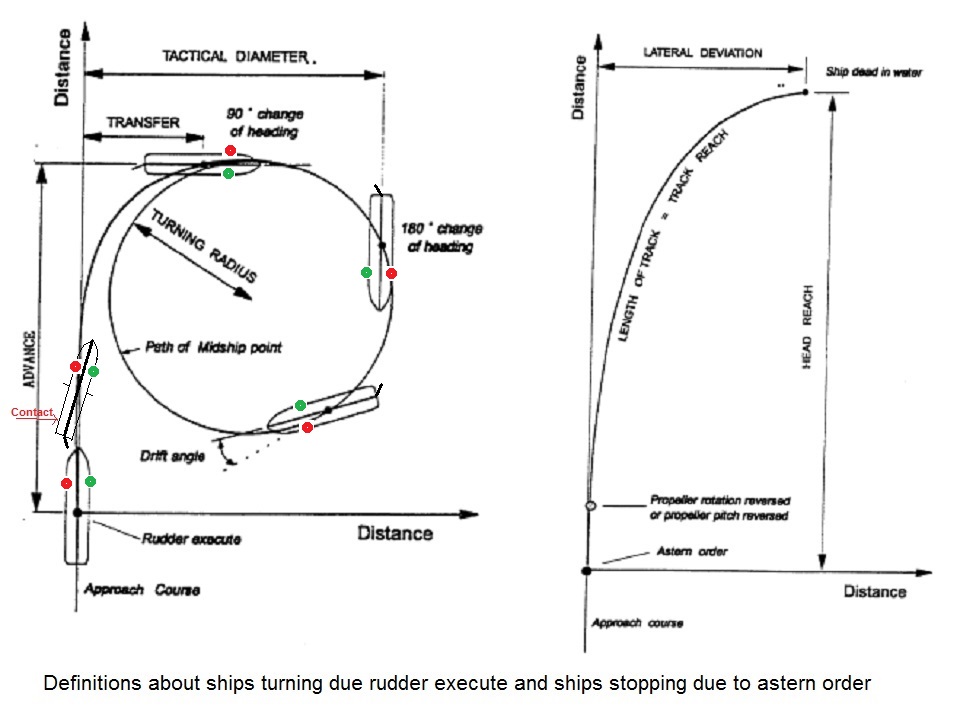 Available data (Annex 31 of the Incident Investigation report from the sea trials 2006) suggests that at approach speed 20.8 knots and giving hard starboard 35° rudder (which takes 20 seconds) the Advance is 686 meters, the Transfer is 219 meters, the Tactical Diameter is 559 meters and the average rate of turning is 0.753°/second. It takes 50 seconds to change heading 37.81° and 60 seconds to change heading 51.87°. The speed drops a lot while turning. According to the experts just before the contact takes place: - 21.44.36 hrs - mid ship (centre) - the bow is less than 150 meters from Scole rock, while the ship is off the planned course by more than 809 meters; Note now rock - singular! But why is the ship 809 meters off course? Didn't they start turning port four, five minutes earlier? And how it is known from a voice recording? Is it the fault of Schettino ? Isn't it clear that any starboard turn simply started FIVE minutes too late? So 16 seconds later the rudder at 35° starboard shall be turned to 0° mid ship (centre) which takes 20 seconds. We do not know if the helmsman does it. - 21.44.43 hrs - port ten (ten degrees to the left), but the helmsman reaches only 5 degrees to the left; 7 seconds later the helmsman shall turn the rudder 10° port. We do not know if he does it. - 21.44.45 hrs - port twenty (twenty degrees to the left) after this order the helmsman heads erroneously to starboard to correct himself and go alongside to port as requested by the Master, and then pulling again to the left as requested by the Master, but spend about 8 seconds for the correction of the manoeuvre; Note that the result of 10° and 20° port rudder, apart from turning vessel's bow to port, is that the aft end of the vessel swings/drifts out to starboard (away from shore/rocks) and that the vessel maybe heels a little to starboard. The ship port side aft cannot contact anything, if the ship turns to port due to a port twenty rudder! It is the port side forward that will contact anything below water. Again the helmsman doesn't understand what to do - a second incident. From p 51 of the report at www.safety4sea.com/images/media/pdf/Costa_Concordia_-_Full_Investigation_Report.pdf (copy/paste the link) we learn: "The helmsman, just in the phases immediately before impact (sic), has made mistakes in the handling of the helm than the orders given by the Master." So it seems, if we can believe the very strange Italian incident report based on some voice recordings, that a major contributory factor of the contact that followed is the helmsman not following the orders of Schettino (crew negligence!) or that steering gear didn't work properly, which is not investigated. It seems the helmsman didn't understand Italian and didn't understand the English spoken by the Italian officers. It appears clear that the maneuver had never been trained. - 21.45.05 hrs - hard to port (rudder to the left). The helmsman runs correctly. But how do we know that the helmsman runs correctly from a voice recording? Now 21.45.05 hrs the aft port aft side should have been swinging out for 22 seconds to starboard away from shore/rock since 21.44.43 hrs. But the damage suggests that the port aft side was pushed to port towards shore/rock when contact occurred indicating vessel was turning to starboard. Maybe the poor helmsman supplied by the ship owner mixed up port and starboard? The Second Deck Officer from the left wing warns that the left side is gone aground (sic), a second later it was heard a loud crash. Strange! Isola del Scole should have been >100 meters away and the rocks outside less than a meter above water. But the contact is several meters below water. At 21 45 07 the ship collides (sic) into (sic) the rocks. The speed decreases to 8.3 knots, loses propulsion of the two engines, and adrift proceeds with direction of 350 °. Etc, etc. Actually it was the ship's port end side that during six seconds contacted something below water ... but who cares? This is not a professional accident investigation report. It is fantasies and if above actually tallies with the Voyage Data Recorder, VDR, data is not clear. Now watertight compartments start to up-flood, i.e. fill with water.
The pre-planned five minutes 37 seconds (sic) turn seems extremely strange. Did the vessel actually respond to the rudder movements, i.e. was the steering installation in order? Does a normal turn 56° (or actually 44°) starboard take five minutes? I would expect the vessel would turn or change heading 56° (or 44°) starboard in less than two minutes. Or did the helmsman simply not know difference between starboard and port? Maybe the helmsman didn't turn the rudders at all! I think the description above -
orders shouted, bla, bla, - is an invention - to
hide something simple and really stupid. And what
could it be? I assume, to really show off,
Schettino himself (or someone else ... a
friend? ... but not the helmsman) did the complete
turn ... which started much later and much closer
to shore ... and that 30 seconds before
contact ... seeing the ship heading straight
up on land ... Schettino violently turned
the rudders to avoid running ashore ... and the
ship's port side kicked the boulder lose six meters
below water ... etc, etc. A really stupid ...
accident! 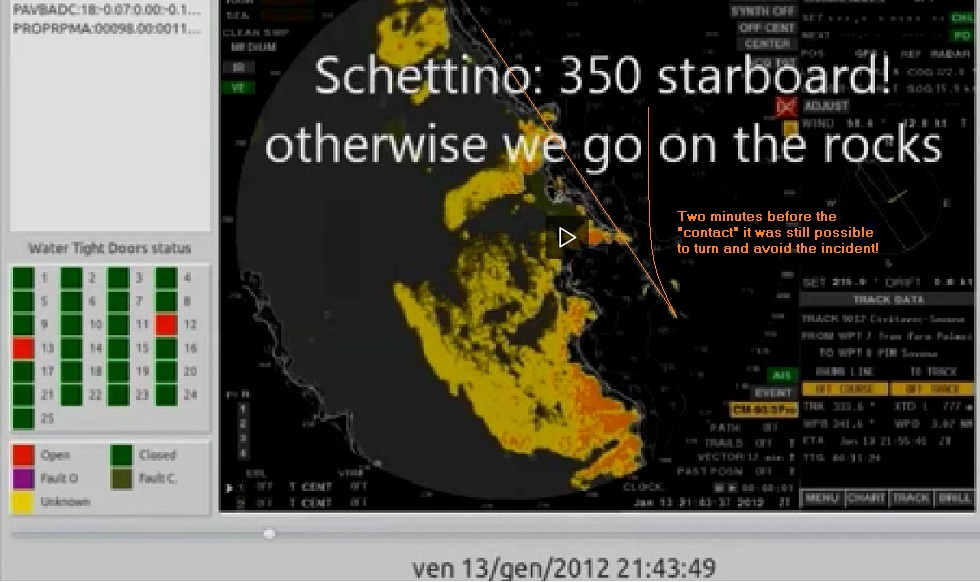 The Voyage Data Recorder (picture above) functioned and it apparently confirms that a starboard turn was initiated much, four minutes, later than suggested above at about 21:43:49 hrs so that the vessel would still pass well clear of any rocks, but, seconds later the ship turned to port (!) heading straight up on land and then, too late, the vessel turned to starboard again ... which resulted in a really stupid, mysterious, accidental contact 80 seconds later! Thus the Voyage Data Recorder info does not tally with the Bridge Voice Recordings! I assume the voice recordings have been manipulated. At 21:43:39 hrs we see on above radar screen that the ship is heading straight up on land and that a change of course 5° starboard would avoid any contact. But no such change of course was done! It seems the ship instead turned to port! As already quoted above: "- 21.44.43 hrs - port ten (ten degrees to the left), but the helmsman reaches only 5 degrees to the left; 7 seconds later the helmsman shall turn the rudder 10° port. We do not know if he does it. - 21.44.45 hrs - port twenty (twenty degrees to the left) after this order the helmsman heads erroneously to starboard to correct himself and go alongside to port as requested by the Master, and then pulling again to the left as requested by the master, but spend about 8 seconds for the correction of the manoeuvre;" 30 (!) seconds before the contact at 21.45.15 hrs Schettino order the ship to steer up on land ... but the helmsman wants, correctly, to steer starboard. You really wonder what went on. Note also the Water Tight Doors status left! It appears the W/T doors were really quick opening/closing as the status changes red/green or green/red quickly. There were 25 W/T doors, most of them closed but several opened and closed before, during and after the turn and afterwards, and at 21.46.20 hrs - less than a minute after the contact but long before black-out occurs, the W/T door status becomes blank so we do not know the situation, e.g. just prior capsize later. The Italian incident investigators suggest all W/T doors were closed. Any opening/closing of an approved W/T door closed at sea must be approved by the officer on watch and recorded in the log book. W/T doors are not permitted on cruise ships except one between engine rooms, so you wonder why there were 25 on M/S Costa Concordia! Being opened/closed when navigating close to shore! Of course something completely different may have happened. Plenty of false information is around, e.g. that five hull compartments were up flooded due to the contact at 21.45 hrs.
But there were many ideas reported in the media early 2012 shown below. One thing is certain. According Costa company policy, established by somebody somewhere, the ship should pass close to islands and interesting places on shore as a salute or show off ... even if was pitch dark and cold outside. The route between ports was planned accordingly ... by the 2nd Officer responsible for route planning and navigation ... and later navigation between way points was virtually automatic by computer and GPS. Actually Costa Concordia was passing Isola del Giglio every Friday since more than a year ... but had only made a close sailing by salute once before (we are told to believe). Imagine, if the way point close to shore were ... too close or GPS were 50 meters off! You wonder, if the planning included closing all watertight doors, having special look-outs, etc? May 2017 we still did not know. Had Italian authorities ruled that cruise vessels must stay at least one mile away from any coast except when leaving/arriving than nothing would have happened. Capt. Antonio Di Lieto has in a
paper Costa
Concordia - Anatomy of an organizational
accident
described six purely organizational and
navigational errors of the team (!) that may have
contributed to the first contact, the
last being Schettino himself not steering
the ship by sight in the dark night from somewhere
but giving funny orders to the helmsman doing the
actual steering on the very large bridge forgetting
earlier plans with plenty of people and officers on
watch around doing nothing or not keeping a proper
lookout, when maybe Schettino became
distracted or carried away by various personnel for
non-operational reasons. Thus the first incident
was a stupid accident? (COLLEEN
BARRY |
Associated Press) The island or rather some
unknown underwater object was in way of the
Costa Concordia, when the ship was saluting
and sailing close by at 15-16 knots for tourists
and fishermen to watch. Schettino and other
officers apparently didn't know that most people on
the island were asleep and not really interested in
any Costa style Magic show off
salute! And there were very few tourists on
the island on this cold winter evening anyway.
Nobody goes to Isola del Giglio to watch Costa
cruise ships speed by ... at a safe distance! So
very few people on the island witnessed the
drama. Source
(page 46) it happened in daylight (sic)
and far away from shore (sic): "A former
passage close to Giglio is recorded on the previous
August. It happened in
daylight, keeping a course
with a safe distance by the
shoreline and proceeding slowly
(manoeuvre speed as she approached the breakwater),
to allow the passenger to film or make picture,
despite the ship was quite far from the
coast." Or it
happened like this? The underwater object (or whatever?) off the island was not detected, we are told, when ship with Schettino at helm or just close to the helmsman, allegedly, made a starboard turn outside island at 21.44 hrs - a little late - or was it 21.39 hrs? I doubt very much that the ship was heeling due to the wide turn as the stabilizer fins were activated to prevent such heeling/rolling, e.g. that loose items and standing people in restaurants and bars would lose balance and fall to the deck prior contact. The Costa Concordia has several sister ships and it is very easy to establish how the ship reacts to sudden rudder movements. There exist on Internet many simulations or animations of unknown reliability of what happened that do not tally with what is suggested above but in all cases the ship continues to move forward. Had the ship been, say 50 meters closer to shore, I assume it would have grounded, ripped open the double bottom and stopped in 10-15 seconds with the vessel stuck on the rocks: 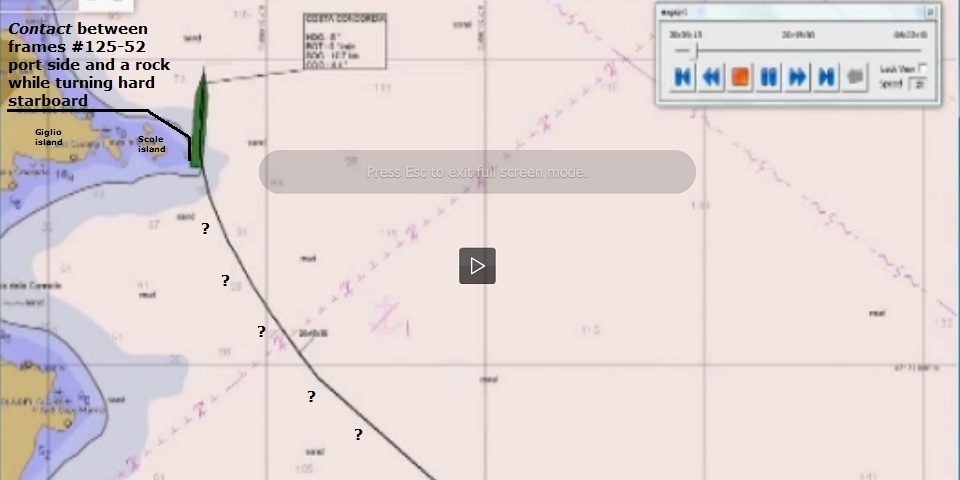
99 years and 9 months earlier British passenger ship RMS Titanic (or was it the already damaged RMS Olympic as part of an insurance fraud?) contacted an iceberg at sea under similar, rather strange to say the least, circumstances, i.e. they didn't watch out, and ripped open 6 watertight compartments of the hull forward below waterline and sank 3 800 meters to the bottom of the sea and landed upside up on the sea floor, which looked like this (according National Geographic - if you believe it?):  The Costa Concordia contact, capsize and sinking case is very interesting! Like all crimes and mysteries at sea. Like this one! March 2015 we learnt that the ship carried drugs for the Italian mafia when it sank. A big shipment was lost. Maybe Costa Concordia passed very close to the two small rocks outside Isole del Scole islets on different approaches? Nobody knows (2017)! There were different charts and a number of simulated trajectories proposed 2012. Look at this: 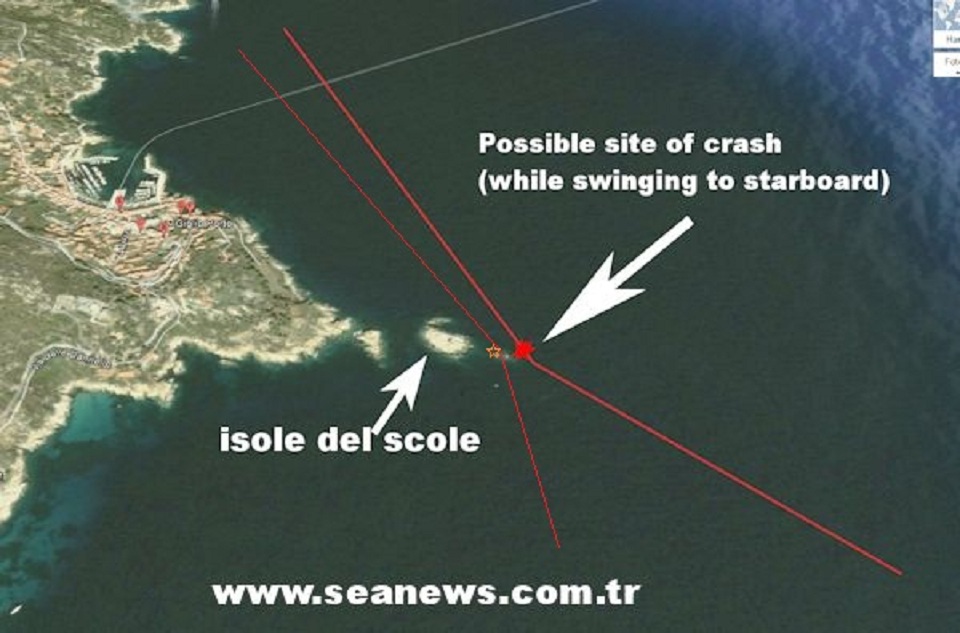
Source: http://www.seanews.com.tr/article/ACCIDENTS/74284/Costa-Concordia-accident-navigational-error/ Another simulation at 21.45 hrs - now safely off the 10 meter depth line and no rocks at all outside the islets (Maybe the 2nd Officers used this strange chart as guidance ... and the whole island was 50-100 meters off the GPS locations?): 
Here is another attempt to simulate the strange contact and what happened afterwards. And another one with Costa Concordia heading for a collision straight up on land at 21.44 hrs - didn't anyone on the bridge look out? ... and no turn until almost up on land:
Lloyd's List Intelligence on the other hand suggests, approximately, Costa Concordia passed >300 meters off Isole del Scole and the rocks on a straight course after having turned a little (not 56°) starboard much earlier: 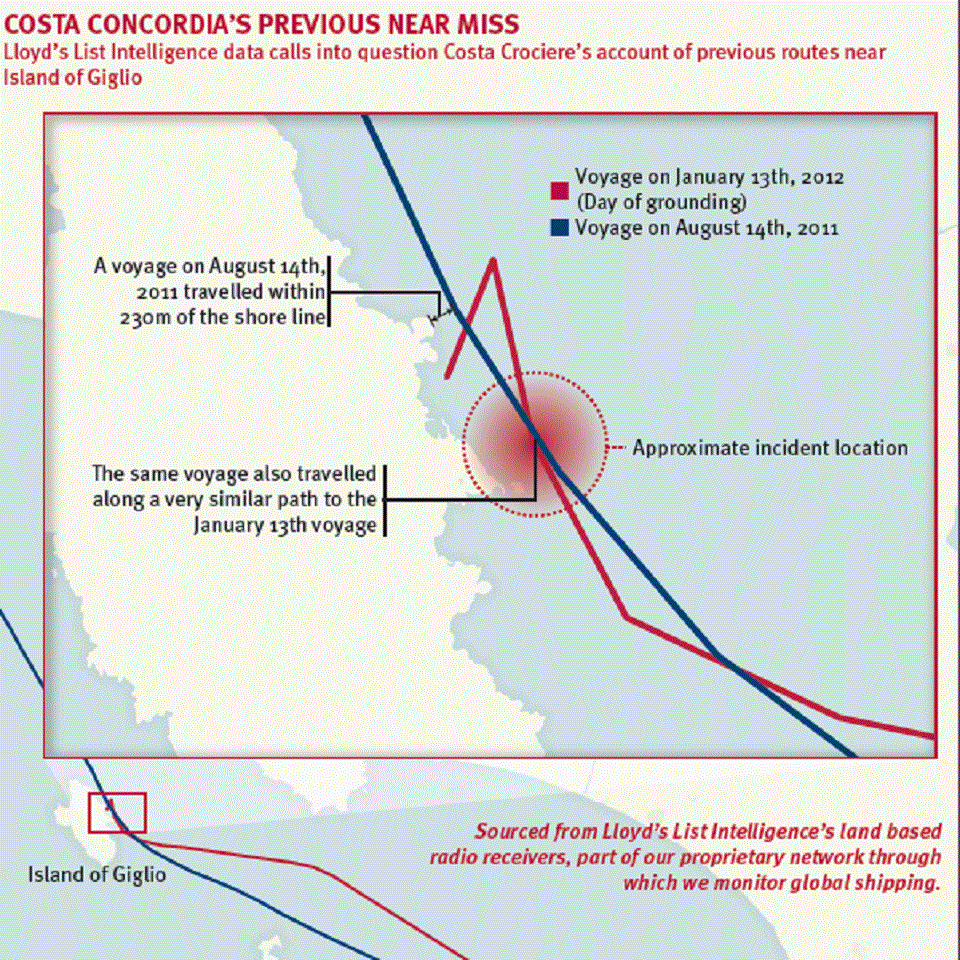
Source: http://www.lloydslist.com/ll/incoming/article389129.ece/BINARY/180112_front_map.pdf All these simulations just confuse and you wonder why they exist and do not tally with the ship's VDR Voyage Data Recorder data or the May 2013 Italian accident investigation report at www.safety4sea.com/images/media/pdf/Costa_Concordia_-_Full_Investigation_Report.pdf (copy/paste the link). Here (see below) is another chart - with two rocks (!) outside Le Scole island, where the contact occurred, and more rocks (!!) outside Punta Gabbianara, where the ship anchored afterwards and later capsized and sank. You should wonder what charts were used for above animations?
Furthermore; according media 2012 (you wonder how they know?) Costa Concordia heeled to port (towards shore) due to a (sharp?) starboard turn (not shown above) prior one contact and port aft vertical side of Costa Concordia, swung out (but also inwards below waterline away from shore) and apparently, one way or another, contacted a granite outcrop on the sea floor and sheared off a 6 meter big, 100 tons, granite piece of granite rock at 15-16 knots and port, aft end underwater hull vertical side was ripped open with the piece of rock lodged in the side ... just below waterline! Flat bottom was not damaged! Vessel started to leak. The weather was good but visibility was reduced due to night. Just like RMS Titanic! Note that ship neither collided with another ship and damaged the vertical side above/below waterline nor grounded its flat bottom with sea floor as the bottom is reported undamaged. Question is - with which rock of two rocks outside Le Scole did Costa Concordia contact? May 2013 - First (confusing) official info what happened According the Italian report Marine casualty on January 13, 2012 - www.safety4sea.com/images/media/pdf/Costa_Concordia_-_Full_Investigation_Report.pdf May 2013 we are told to believe that the following happened on the bridge leading up to the contact: "At 21 45 07 (hrs) the ship collides (sic) into (sic) the rocks. Evidently the stationary rock did not collide with the ship but the ship just unfortunately, accidentally contacted the rock on the sea floor damaging its port side causing up-flooding of three hull compartments. Vessel neither sank nor capsized and nobody died due to the contact on 13 January, 2012. And any watertight door permitted by SOLAS with operational instructions provied by the Italian Maritime Authority should have been closed at departure. Were they? Does SOLAS allow 25 watertight doors? Does SOLAS allow two watertight doors in one bulkhead? Answer is NO! The ship was incorrectly built and certified and ... not seaworthy. Another description - in Italian - of the above drama leading to the contact is found on pp 76-82 of the 2012 preliminary report by the Italian court appointed experts. The watertight doors are described on p 178. This report has two figures #8 and #9 - the radar screen recorded by the Voyage Data Recorder:
Everything looks normal. The turn has started early. But then there is no more figures or data. The VDR data is not available! Except the version left.
Strange, isn't it. You should in any case wonder if
above descriptions are correct. Knowing with what
ease it is to turn the vessel 44° in less than
90 seconds, while advancing <700 meters, it
still remains a mystery why the vessel came so
close to shore in the end unless the starboard turn
was initiated four minutes late. Regardless, it was a strange,
stupid, fly-by contact (!) with and
shearing off of a piece of granite - only 100 tons
- somewhere that then pushed in, ripped open and
got stuck in the vertical side just 1 meter
below waterline ... we are told to believe.
Evidently a very stupid accident. You
cannot really blame Schettino for it. The
helmsman (provided by the ship owner) appears
pretty useless. Was he competent? We do not
know! Accident happens, maybe, but the
rock must then be just 1 meter below water
and the ship's draught was >8 meter?
Hm! You wonder, if Schettino /crew knew where they were at all! The ship's VDR data should of course say what happened. The resulting, very unusual, serious and unexpected hull damage on port vertical side is seen below:  Photo - Anders Björkman 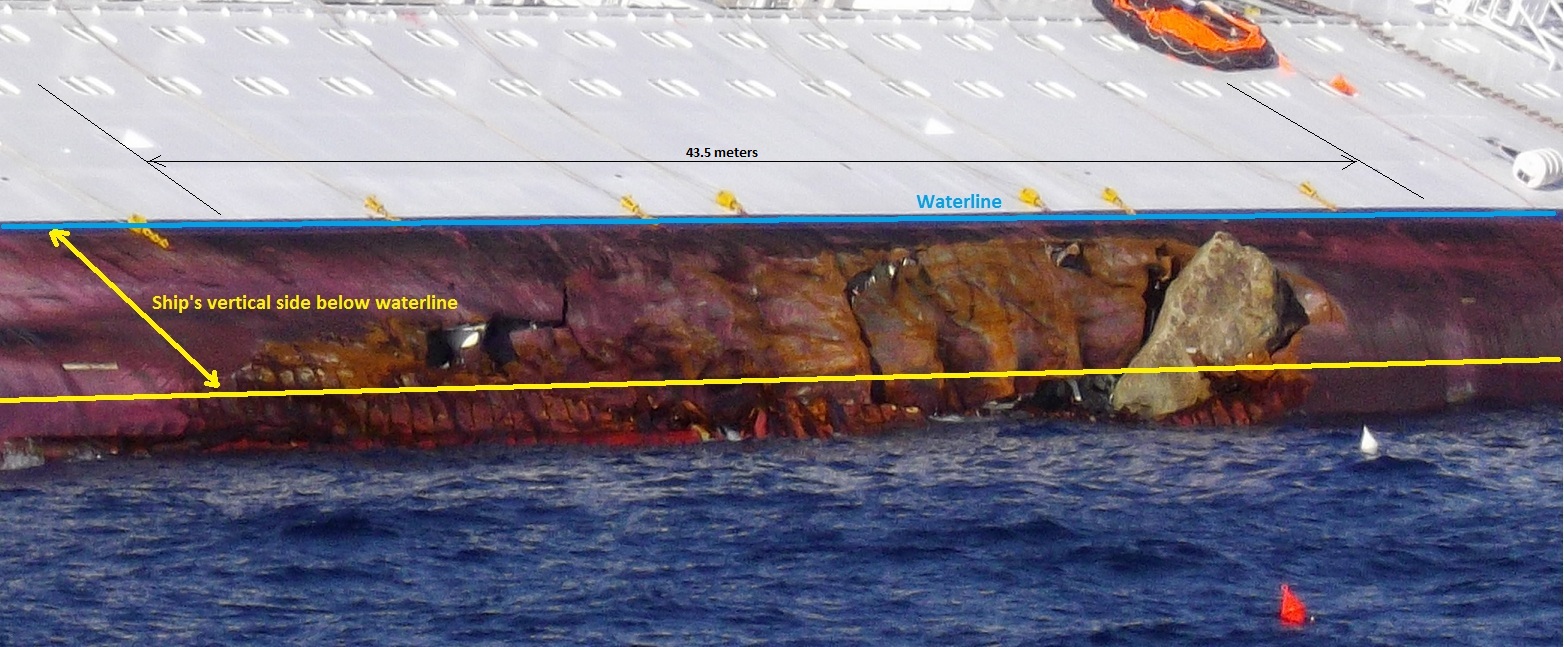 Photo - Anders Björkman 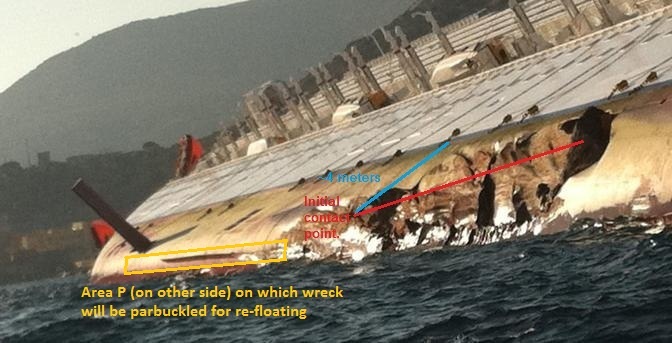 The contact hull damage is as follows - Source: www.safety4sea.com/images/media/pdf/Costa_Concordia_-_Full_Investigation_Report.pdf (pp 101-102): "According to the photogrammetric investigations carried out and, considering that in the area interested by the damage the frame interval is equal to 725 mm, we can deduct that the deformed part extends in length from 413 mm forward of frame no. 124 until 330 mm aft of frame no. 52, for a total length of 52,943 m. Any suggestion that watertight compartments no. 3 or 8 were up-flooded due to the contact are thus false. This is very easy to confirm April 2017! The ship was in dry-dock at Genoa 2016/7 and the damage could be inspected close-up! It wasn't done The stability with four compartments up-flooded was in order (only intermediate stages were critical) - Source: www.safety4sea.com/images/media/pdf/Costa_Concordia_-_Full_Investigation_Report.pdf (p 127): "As far as the two damages to four flooded compartments are concerned, the m/v COSTA CONCORDIA, although complying with all the damage stability criteria provided by SOLAS 74 Consolidated Edition 2004, during the intermediate stages does not show satisfactory stability criteria. As a matter of fact considering the damage to the compartments 4-5-6-7 (DS04-07) the margin line results submerged by 0,111 m., the range of stability is practically null (actual 0,09° against 15°) and the diagram area under the lever curve in the range of stability results null, so that such damage is a quite critical stability situation due to the consequences of the progressive flooding (leakage of water from the damaged compartments to the intact ones) even though the GM is satisfactory enough (GM=0,91M). Furthermore the progressive flooding of the compartments aft of no. 4 is almost (sic) reached, i.e. aft of frame no. 44." The above was also confirmed aboard. After contact the vessel was floating, stable and with no heel. Evacuation and abandon ship was possible. Later the ship could be towed to a port for repairs. The ship was therefore 100% safe - but abandon ship was still necessary! Schettino was quite happy. The ship could be towed for repairs next morning. It would appear that the capsize the next day was due to progressive flooding through leaking, illegal watertight doors. You cannot blame Schettino for that. There are people not believing the above. Go to Part 2. Back to Introduction!
|